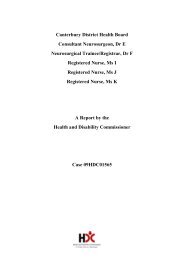Gisborne Hospital Report - Health and Disability Commissioner
Gisborne Hospital Report - Health and Disability Commissioner
Gisborne Hospital Report - Health and Disability Commissioner
Create successful ePaper yourself
Turn your PDF publications into a flip-book with our unique Google optimized e-Paper software.
<strong>Gisborne</strong> <strong>Hospital</strong> 1999 – 2000<br />
Operating Theatre Protocols<br />
assure them management had heard <strong>and</strong> was taking their complaints<br />
seriously.”<br />
3.29 The second inquiry was an internal audit conducted by Dr Peter Gow<br />
(Chairman of the Clinical Board, South Auckl<strong>and</strong> <strong>Health</strong>) <strong>and</strong> Mary Gordon<br />
(Director of Nursing Practice, South Auckl<strong>and</strong> <strong>Health</strong>). The Gow/Gordon<br />
audit report, dated 22 September 2000, recommended:<br />
“A more formal procedure to acknowledge receipt of incident forms to<br />
the quality co-ordinator needs to be in place. A copy of the incident<br />
form needs to be kept in the service area from which the report has<br />
come. This would then allow an audit by the service of the action<br />
which results from the reporting of incidents. The incident reporting<br />
system needs to be accompanied by an educational process, which could<br />
be enhanced by details of the protocols for reporting being attached to<br />
the incident form booklet.”<br />
Appropriate st<strong>and</strong>ards<br />
3.30 Following problems in both Melbourne <strong>and</strong> Whangarei of syringe re-use by an<br />
anaesthetist, the Council of the Australian <strong>and</strong> New Zeal<strong>and</strong> College of<br />
Anaesthetists agreed upon a clarification <strong>and</strong> expansion of the College’s<br />
“Policy on Infection Control P28” (1995). This recommendation was issued in<br />
May 2000 (after Dr Lucas’ departure from <strong>Gisborne</strong>).<br />
3.31 The text of this recommendation is:<br />
“Recommendation of Re-use of ‘Single Use’ Equipment for Invasive<br />
Procedures – May 2000<br />
The labelling of products as ‘single use’ is an indication by the<br />
manufacturer that the product is either unable to be re-sterilised or its<br />
safe function may be compromised by the re-sterilisation process.<br />
As sterilisation is required for the apparatus that will be used for any<br />
invasive procedure (eg intravenous access, regional anaesthesia <strong>and</strong><br />
invasive monitoring), such apparatus labelled ‘single-use’ must not be<br />
reused. This includes all apparatus that is in continuity with the vascular<br />
system.”<br />
3.32 As Dr Alan McKenzie, Deputy Chairman of the New Zeal<strong>and</strong> National<br />
Committee of the Australian <strong>and</strong> New Zeal<strong>and</strong> College of Anaesthetists, made<br />
clear to Dr Peter Schaap of <strong>Gisborne</strong> <strong>Hospital</strong> in a letter dated 13 June 2000,<br />
this recommendation “makes perfectly clear that re-use of ‘single-use’ devices<br />
for invasive procedures or accessing the vascular system of patients is not an<br />
acceptable practice”. The recommendation was sent to the Chief Executives<br />
of all surgical hospitals <strong>and</strong> to all doctors identifying anaesthesia as an area of<br />
practice in information supplied to the Medical Council of New Zeal<strong>and</strong>.<br />
3.33 Before this recommendation was issued the position of the College on the reuse<br />
of “single use” equipment for invasive procedures had not been explicit<br />
80
















